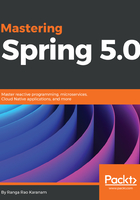
上QQ阅读APP看书,第一时间看更新
Keep up with changing times
The first version of Spring Framework focused on making applications testable. However, as time moved on, there were new challenges. Spring Framework managed to evolve and stay ahead of the curve with the flexibility and modules that are offered. A couple of examples are listed as follows:
- Annotations were introduced in Java 5. Spring Framework (version 2.5 – Nov 2007) was ahead of Java EE in introducing an annotation-based controller model for Spring MVC. Developers using Java EE had to wait until Java EE 6 (Dec 2009 – 2 years) before having comparable functionality.
- Spring Framework introduced a number of abstractions ahead of Java EE to keep the application decoupled from specific implementation. Caching API provides a case in point. Spring provided a transparent caching support in Spring 3.1. Java EE came up with JSR-107 for JCache (in 2014)--support for which was provided in Spring 4.1.
Another important thing Spring brings in is the umbrella of Spring Projects. Spring Framework is just one of the many projects under Spring Projects. We will discuss the different Spring Projects in a separate section. The following examples illustrate how Spring managed to stay ahead of times with new Spring Projects:
- Spring Batch defines a new approach to building Java Batch applications. We had to wait until Java EE 7 (June 2013) to have comparable batch application specification in Java EE.
- As architecture evolved toward Cloud and microservices, Spring came up with new Cloud-oriented Spring Projects. Spring Cloud helps in simplifying the development and deployment of microservices. Spring Cloud Data Flow provides orchestrations around microservice applications.